Hubbard Street Dance Chicago appears at the Jacob’s Pillow Dance Festival.
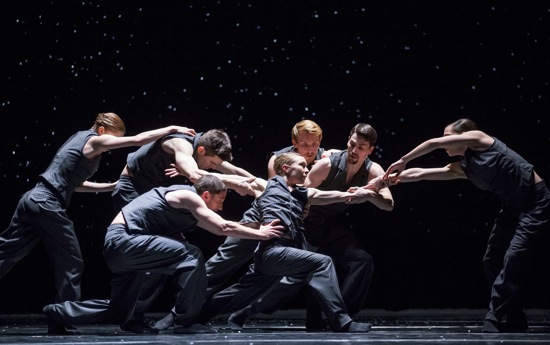
Hubbard Street dancers in Solo Echo by Crystal Pite. Clockwise from left: Emilie Leriche, Michael Gross, Florian Lochner, Andrew Murdock, Jacqueline Burnett, Kellie Epperheimer (foreground), and Jesse Bechard. Photo: Todd Rosenberg
I first saw Crystal Pite’s choreography by in 2008, when Cedar Lake Contemporary Ballet (sadly defunct) commissioned her Ten Duets on a Theme of Struggle (performed in rotation by five dancers). The most recent Pite work I wrote about was her 2015 Polaris, one of four works in Sadlers Wells London’s Lincoln Center presentation of “Thomas Adès: Concentric Paths—Movements in Music;” Polaris augmented six dancers with sixty-six more from New York University Tisch School of the Arts. Last week, Hubbard Street Dance Chicago included on its Jacob’s Pillow program her 2008 A Picture of You Falling and Solo Echo (premiered in 2012 by Nederlands Dans Theater). What strikes me about Pite is not just how gifted she is, but the originality with which she conceives each work and how diverse they are.
Jesse Bechard performed the solo A Picture of You Falling at the performance I attended—a man in a white shirt, black jacket and trousers standing and waiting. A recorded woman’s voice says, “Look. This is you.” There’s a heavy thud in Owen Belton’s surely made-to-order score, and the man winces. He is not yet falling, but he is beginning the long-drawn-out act of doing so. (If this is what being him entails, I’d better prepare.)
Bechard seems to be collapsing internally and from invisible blows. Knees, hips, elbows, head. Did the voice say that? Although more aural thuds and crashes and crunches punish the air around him, and he may be on his knees, he’s not giving up. He reels from one side of the stage to the other, as if beset by gales, but stays on his feet. Here’s the most terrible thing that the voice announces: “This is the sound of your heart hitting the floor.”
In the end, Bechard is advancing resolutely toward the downstage corner where he began—a few steps forward, three steps back, a few steps forward. Then he turns his back on us and walks into darkness. “This is how it ends.” This is how it ends??
This exceptionally fine dancer is also prominent among the seven I saw perform Pite’s Solo Echo (it’s double cast). As the title suggests, we may be seeing iterations of a single person and the moves he makes. Pite was inspired by Mark Strand’s poem “Lines for Winter,” which is printed in the program. It begins, “Tell yourself/ as it gets cold and gray falls from the air/ that you will go on walking, hearing/ the same tune no matter where/ you find yourself. . . .”
And it ends “tell yourself/ in that final flowing of cold through your limbs/ that you love what you are.”
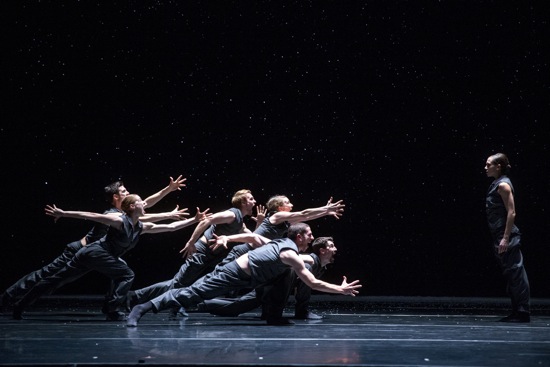
Crystal Pite’s Solo Echo. Jacqueline Burnett, far right with, clockwise from left: Michael Gross, Florian Lochner, Kellie Epperheimer, Andrew Murdock, Jesse Bechard (foreground), and Emilie Leriche. Photo:Todd Rosenberg.
Those feelings unspool in beautiful enigmatic ways to the accompaniment of excerpts from two Sonatas for Cello and Piano by Johnannes Brahms: the “Allegro non troppo” from Opus 38 and the “Adagio affectuoso” from Opus 39. The dancers don’t follow the music closely, but are always attuned to it. Jay Gower Taylor’s stage design is a mysterious cluster of snowflakes—mysterious because at first they appear as a broad band of little flakes that shiver and glisten Tom Visser’s light, but do not seem to fall until later, when their dancing pattern fills the back wall of the stage.
The surface of the floor seems slippery; the dancers, wearing socks, often skid into place. Pite reveals them (Jacqueline Burnett, Jeffery Duffy, Kelley Epperheimer, Michael Gross, Emilie Leriche, Andrew Murdock, and Bechard) in two and threes, in solitary moments, in chains. No one, as I remember it, leaps. They fall and rise, women are lifted, people lean away from and toward one another or in relation to some unseen goal. One motif stands out—because it is repeated in so many ways, and because it is so resonant. It’s simply this; a dancer rushes across the stage and into a lunge that makes him/her look momentarily like a runner frozen in mid-stride (sometimes with a silent howl). When almost all of them enter like this together or with some slightly ahead of the others, they suggest an avalanche brought up short, or, more importantly, vividly illustrate Pite’s idea of an individual multiplying.
Hubbard Street Chicago has gone through several changes since its founding by Lou Conte in the later 1970s. I remember it as jazz-oriented in its early days. I recall too that, at some point, the company became the repository for a number of works from Twyla Tharp’s repertory. Glenn Edgerton, who took over as the position of artistic director from Jim Vincent in 2009, had danced in the Joffrey Ballet and in Nederlands Dans Theater, as well as directing the latter for ten years. He’s familiar with works by prominent European dancemakers.
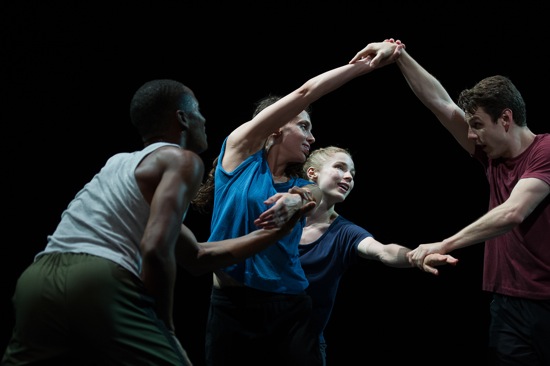
William Forsythe’s N.N.N.N. Hubbard Street dancers (L to R): Jeffery Duffy, Jacqueline Burnett, Emilie Leriche, Kevin J. Shannon. Photo: Christopher Duggan
The program presented at the Pillow included pieces by two young choreographers who began as dancers in the company, Robyn Mineko Williams’s Waxing Moon (2014) and an excerpt from Alejandro Cerrudo’s Second to Last (2013), as well as an import, William Forsythe’s N.N.N.N., created for his Ballett Frankfurt in 2002. These works share a number of qualities. They all present dancers as highly flexible creatures—not in terms of extreme moves such as legs kicked sky high—but people who can instigate a movement with one part of their bodies and transfer the impetus to another midway through. Head, shoulder, ribcage, hips, legs, arms, head: any one of these can start a movement rippling and then arrest it. They jump, of course, but they also drop to the floor and rise; often they work from a wide-legged bent-kneed stance that gives them an animal power. In all three of these works, as in Pite’s, you can admire the nuanced complexity they have mastered. It’s just that sometimes you can’t easily find the spine of the work, the thematic glue that holds the whole thing together.
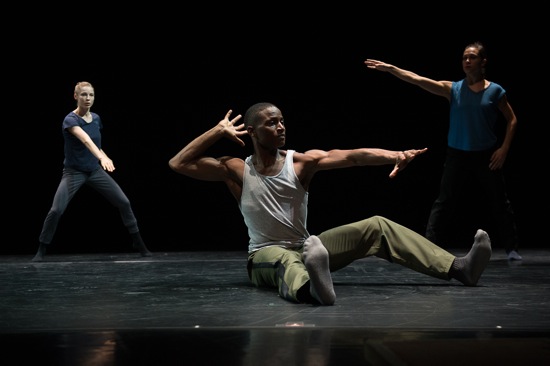
William Forsythe’s N.N.N.N. (L to R): Emilie Leriche, Jeffery Duffy, and Jacqueline Burnett. Photo: Christopher Duggan
When N.N.N.N. begins, in silence, Kevin J. Shannon is checking his arm, how it works, what it can do. Some stylistic qualities emerge. He may swing one arm into the air by hitting it lightly with the other; loose and flying, the struck arm may end up with its hand on his head. As Burnett joins him onstage, and then Duffy and Leriche enter, that notion of getting stuck and pulling free becomes prominent. The dancers own bodies behave in complex ways, as if they can’t get always get their limbs to think for themselves. They wind themselves into interesting ways of connecting (whose leg goes where?), and they form elaborate tangles. These maneuvers are neither comical nor awkward; the aim of the expert dancers seems to be to make this quartet work smoothly, and they do.
There’s a score by Thom Willems, but it’s almost unnoticeable; what you hear is the increasingly heavy breathing of the performers, The getting-glued-together image is reinforced by the ending of the work. Knotted in a complicated pose, the four suddenly fly apart as if a rope had suddenly given way and rush offstage in different directions.
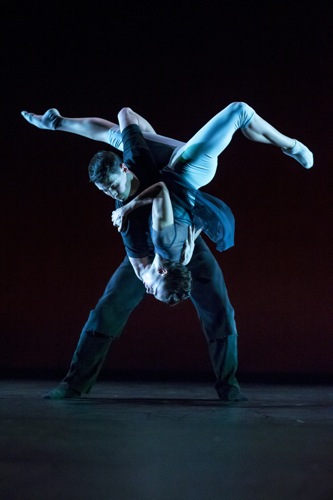
Jacqueline Burnett and Andrew Murdock in Robyn Mineko Williams’ s Waxing Moon. Photo:
Todd Rosenberg
In Williams’s Waxing Moon, set to a commissioned score by Burke Brown, Andrew Murdock is initially confined to a chair set down left on a white square. Perhaps confined is the wrong word, since he moves strenuously in and around it, but it is his “place.” He can be lured away, and, as this is a trio, you imagine that he may be choosing a partner or simply learning through his experiences with both the others. The piece and its gentle music, in which the piano predominates, can also suggest remembered encounters. Twice Jason Hortin enters, adjusts the chair’s position, and leaves. There are moments of conflict between the men. A solo danced by the wonderfully expressive Burnett juxtaposes slow, thoughtful movements and strong, fast ones; it’s almost as if an elastic ribbon has been stretched to its extreme, released, and stretched again. Hortin walks across the stage and, without preliminaries, lifts her into a slow, serene duet, continuing to lift her in many different ways. Once (I don’t know how to explain this properly), she walks up the underside of his leg. The piece ends with Murdock spinning, bearing Burnett stretched across his arms.
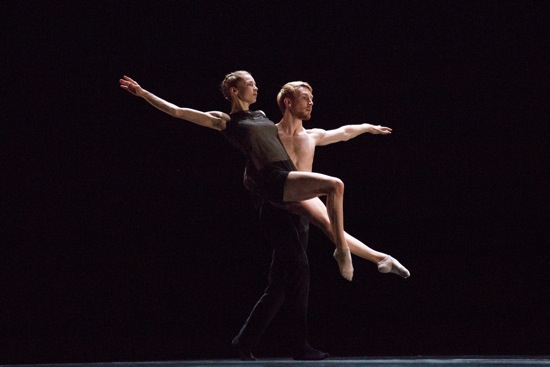
Emilie Leriche and Florian Lochner in Alejandro Cerrudo’s Second to Last. Photo: Hayim Heron
The excerpt from Cerrudo’s Second to Last is set to Arvo Pärt’s Spiegel im Spiegel, the same quiet, questioning melody that inspired Christopher Wheeldon’s memorable duet for Wendy Whelan and Jock Soto, After the Rain. Cerrudo provided an extremely useful work for Hubbard Street, in that it’s a series of five duets, and we learn to appreciate the fluidity, the elasticity, and the commitment of the splendid dancers (Alice Klock and Michael Gross, Alicia Delgadillo and Shannon, Lerich and Florian Lochner, Jessica Tong and Jason Hortin, Ana Lopez and David Schultz). Certain movements conveying tenderness and exploratory connections are repeated or varied, but the overall image is of a parade of lovers making complexity look simple, unaffected, and without stress.
I was impressed, not only by the dancers who delivered all the dances with skill, sweat, ardor, and intelligence, but by the tenor of the program itself. There was no attempt on anyone’s part to thrill spectators with conventional virtuosity or entertain them with light, charming frolics or excite them with aren’t-I-sexy? displays. This was serious, demanding stuff delivered with theatrical savoir-faire, but without a trace of affectation.

Terrific review, summarizes neatly much of the current Terpsichorean zeitgeist. A question: you say you were impressed. I’d like to know if you were moved, or even if you think it’s necessary for an audience member to *be* moved.